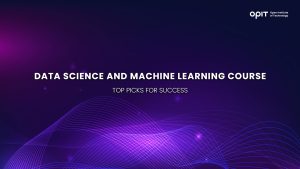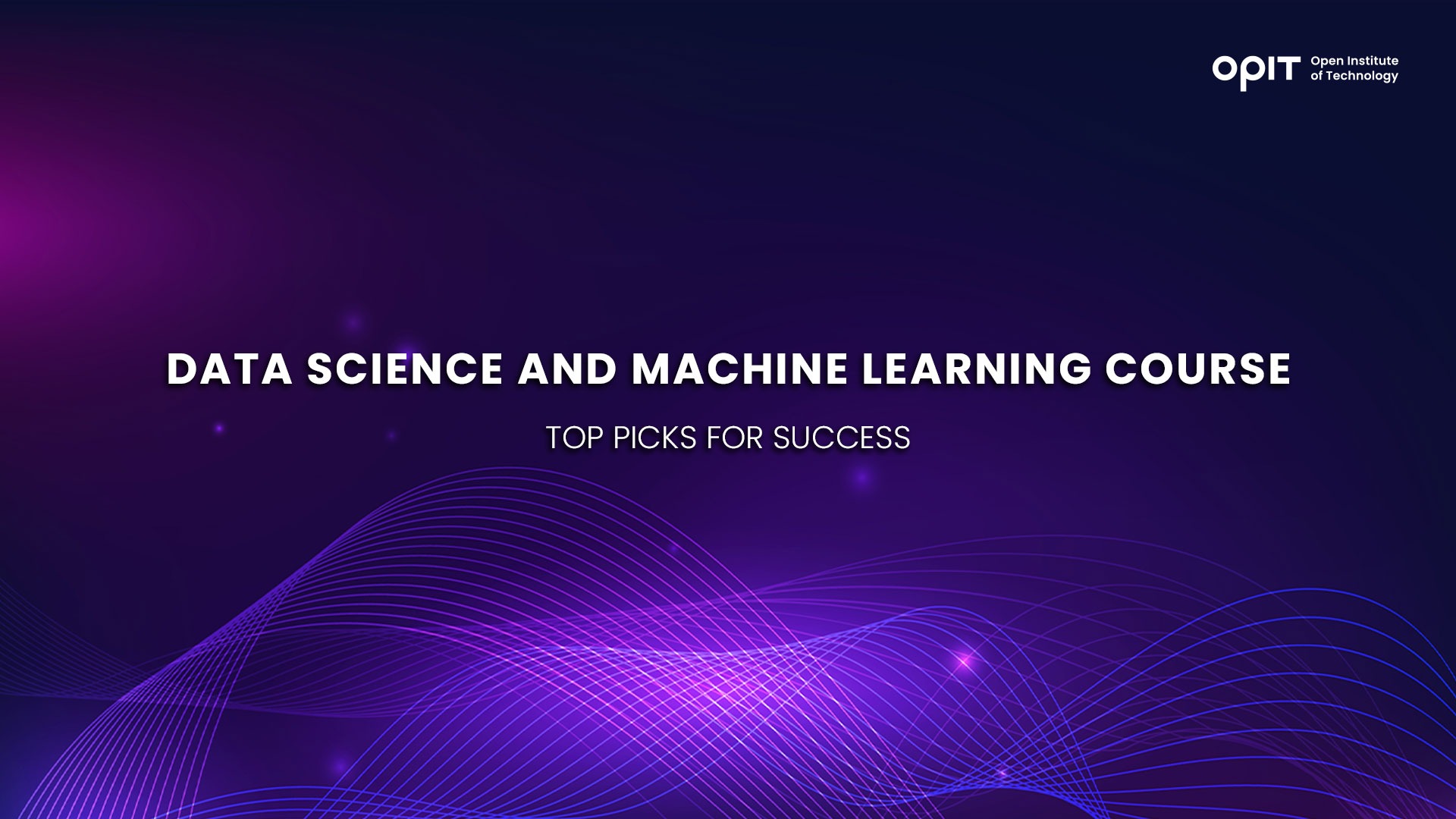

As the world becomes increasingly data-driven and computing power advances beyond all expectations, two intriguing fields are at the center of attention – data science and machine learning.
These fields are often grouped together as they have numerous contact points. First and foremost, both areas are all about data. But data science primarily focuses on extracting valuable insights from data, while machine learning aims to use the data to make predictions and decisions without explicit programming.
These revolutionary technologies have seeped into (and revolutionized) virtually every existing sector: healthcare, business, finance, retail, IT, and the list can go on and on. So, no wonder companies are constantly seeking highly skilled professionals in these fields.
If you’d like to build a career in these highly lucrative fields, improving your skills and knowledge is an absolute must.
Luckily, nowadays, you don’t have to leave your home to achieve this level of expertise. Just pick a data science and machine learning course from this list (or do all three!), and you’ll be well on your way toward a bright future in these burgeoning fields.
Top Data Science and Machine Learning Courses
Whether you’ve just started to dip your toes in these fields or want to take your skills to the next level, you’ll find the perfect data science and machine learning course on our list.
Data Science: Machine Learning by Harvard University
The first data science and machine learning course on the list is classified as an introductory course. In other words, it’s ideal for beginners.
The course first tackles the basics of machine learning, gradually digging deeper into popular algorithms, principal component analysis, and building recommendation systems. You’ll finish this course with fundamental data science and machine learning skills.
The class lasts eight weeks and is entirely self-paced. The recommended time commitment is two to four hours per week, but every learner can tailor it to their needs. Another great option is auditing this data science and machine learning course for free. But you’ll have to pay a fee for a verified certificate and unlimited access to the materials.
The $109 (a little over €101) cost is a small price for the theoretical and hands-on knowledge you’ll gain after this course.
Unfortunately, not everyone will be given a chance to gain this knowledge. Due to some licensing issues, this course isn’t available for learners in Iran, Cuba, and Ukraine (the Crimea region). Another potential downside is that the class is a section of a nine-part data science program. And most of those nine parts precede this course. Although not obligatory, the program creators recommend taking these courses in order, which can be too much time and financial commitment for some learners.
Machine Learning, Data Science, and Deep Learning With Python by Udemy
Do you feel like you need more hands-on experience in machine learning and data science? Have you had to pass on promising job applications because you don’t meet the listing requirements? If you’ve answered positively to both questions, here’s some good news. This data science and machine learning course was custom-made for you.
And no, these aren’t empty promises à-la infomercials you see on TV. This course covers all the most common requirements big-tech companies seek in data scientist job listings. Implementing machine learning at a massive scale, making predictions, visualizing data, classifying images and data — you name it, this course will teach it.
Naturally, this is the single most considerable advantage of this course. It will give you the necessary skills to successfully navigate the lucrative career paths of data science and machine learning. But this only goes if you already have some experience with coding and scripting. Unfortunately, this course isn’t beginner-friendly (in terms of Python, not data science), so not everyone can take it immediately.
Those who do will enjoy over 100 on-demand video lectures, followed by several additional resources. For a $119.99 (approximately €112) fee, you’ll also receive a shareable certificate and full lifetime access to the course.
Data Science and Machine Learning: Making Data-Driven Decisions by MIT
The last item on our list is a big-league data science and machine learning course. The word “course” might even be an understatement, as it’s closer to an entire learning program encompassing a broad set of educational activities.
For starters, the course involves a mentorship program with leading industry experts as guides. And this isn’t a one-and-done type of program either; you’ll have weekly online meetings in small groups. The course itself is taught by MIT faculty and industry experts with years of experience under their belts.
In 12 weeks, you’ll significantly grow your data science and machine learning portfolio, examine numerous case studies, acquire valuable knowledge in applying multiple skills (clustering, regression, classification, etc.), and receive a professional certificate to prove it.
The only notable downside of this extensive data science and machine learning course is its price. With a $2,300 (around €2,142) fee, this course is far from accessible for an average learner. However, those who can afford it should consider it a long-term investment, as this course can be a one-way ticket to a successful career in data science and machine learning.
Factors to Consider When Choosing a Course
Online learning platforms have democratized the world of learning. Now, you can learn whatever you want from wherever you are and at whatever pace works best for you.
But keep in mind that this goes for instructors as well. Anyone can now teach anything. To avoid wasting your time and money on a subpar course, consider these factors when choosing the perfect data science and machine learning course.
Course Content and Curriculum
First things first: check what the course is about. The course’s description will usually contain a “Curriculum” section where you can clearly see whether it delves into topics that interest you. If you have experience in the field, you’ll immediately know if the course spends too much time on skills you’ve already mastered.
Course Duration and Flexibility
Most online courses are self-paced. Sure, this kind of flexibility is mostly a good thing. But if you lack discipline, it can also be detrimental. So, before starting the course, check its duration and make sure you can fully commit to it from beginning to end.
Instructor Quality and Expertise
A data science and machine learning course will undoubtedly contain portions some learners might perceive as challenging or tedious. If there’s one thing that can help them breeze through these parts, it’s an engaging and personable instructor.
So, before committing to a course, research the instructor(s) a little bit. Check their bios and play a video to ensure their teaching style works for you.
Cost and Return on Investment
A data science and machine learning course can cost upwards of thousands of dollars. To ensure you’ll get your money’s worth, check how well it will prepare you for finding a job in the field.
Does it come with a highly requested certification? Does it cover the skills your future employers seek? These are just some of the questions you should consider before investing in a data science and machine learning course.
Hands-On Experience and Real-World Projects
This is another factor that can make investing in a data science and machine learning course well worth it. As valuable as theory is, hands-on experience is king in these fields. Working on real-world projects and building a rock-solid portfolio opens up new doors for you, even before leaving the course.
Networking Opportunities and Job Placement Assistance
A strong support system and direct contact with instructors and mentors should be a course must-have for anyone interested in a data science and machine learning career. Meet notable figures in the industry and stand out among the course goers, and incredible job opportunities should follow suit.
Tips for Success in Data Science and Machine Learning Courses
You can get straight to learning after selecting the perfect data science and machine learning course. Sure, closely following the curriculum will help you gain the necessary knowledge and skills in these fields. But following these tips while studying will do wonders for your future career prospects:
- Develop a strong foundation in mathematics and programming: This will allow you to take more advanced courses and breeze through the rest.
- Stay up-to-date with industry trends and advancements: Despite being updated frequently, the courses can barely keep up with the innovations in the field.
- Engage in online forums and communities for support and networking: Sharing ideas and receiving feedback can help you overcome learning challenges.
- Practice your skills through personal projects and competitions: Challenge yourself to go beyond the scope of the course.
- Seek internships and job opportunities to gain real-world experience: Besides looking great on your resume, these will help you get the hang out of things much quicker.
Learn, Practice, Excel
A carefully selected data science and machine learning course is an excellent opportunity to enter these booming fields with a bang. Developing data science and machine learning skills further will help you stay there and enjoy a successful and rewarding career for years to come.
Related posts

Source:
- Agenda Digitale, published on November 25th, 2025
In recent years, the word ” sustainability ” has become a firm fixture in the corporate lexicon. However, simply “doing no harm” is no longer enough: the climate crisis , social inequalities , and the erosion of natural resources require a change of pace. This is where the net-positive paradigm comes in , a model that isn’t content to simply reduce negative impacts, but aims to generate more social and environmental value than is consumed.
This isn’t about philanthropy, nor is it about reputational makeovers: net-positive is a strategic approach that intertwines economics, technology, and corporate culture. Within this framework, digitalization becomes an essential lever, capable of enabling regenerative models through circular platforms and exponential technologies.
Blockchain, AI, and IoT: The Technological Triad of Regeneration
Blockchain, Artificial Intelligence, and the Internet of Things represent the technological triad that makes this paradigm shift possible. Each addresses a critical point in regeneration.
Blockchain guarantees the traceability of material flows and product life cycles, allowing a regenerated dress or a bottle collected at sea to tell their story in a transparent and verifiable way.
Artificial Intelligence optimizes recovery and redistribution chains, predicting supply and demand, reducing waste and improving the efficiency of circular processes .
Finally, IoT enables real-time monitoring, from sensors installed at recycling plants to sharing mobility platforms, returning granular data for quick, informed decisions.
These integrated technologies allow us to move beyond linear vision and enable systems in which value is continuously regenerated.
New business models: from product-as-a-service to incentive tokens
Digital regeneration is n’t limited to the technological dimension; it’s redefining business models. More and more companies are adopting product-as-a-service approaches , transforming goods into services: from technical clothing rentals to pay-per-use for industrial machinery. This approach reduces resource consumption and encourages modular design, designed for reuse.
At the same time, circular marketplaces create ecosystems where materials, components, and products find new life. No longer waste, but input for other production processes. The logic of scarcity is overturned in an economy of regenerated abundance.
To complete the picture, incentive tokens — digital tools that reward virtuous behavior, from collecting plastic from the sea to reusing used clothing — activate global communities and catalyze private capital for regeneration.
Measuring Impact: Integrated Metrics for Net-Positiveness
One of the main obstacles to the widespread adoption of net-positive models is the difficulty of measuring their impact. Traditional profit-focused accounting systems are not enough. They need to be combined with integrated metrics that combine ESG and ROI, such as impact-weighted accounting or innovative indicators like lifetime carbon savings.
In this way, companies can validate the scalability of their models and attract investors who are increasingly attentive to financial returns that go hand in hand with social and environmental returns.
Case studies: RePlanet Energy, RIFO, and Ogyre
Concrete examples demonstrate how the combination of circular platforms and exponential technologies can generate real value. RePlanet Energy has defined its Massive Transformative Purpose as “Enabling Regeneration” and is now providing sustainable energy to Nigerian schools and hospitals, thanks in part to transparent blockchain-based supply chains and the active contribution of employees. RIFO, a Tuscan circular fashion brand, regenerates textile waste into new clothing, supporting local artisans and promoting workplace inclusion, with transparency in the production process as a distinctive feature and driver of loyalty. Ogyre incentivizes fishermen to collect plastic during their fishing trips; the recovered material is digitally tracked and transformed into new products, while the global community participates through tokens and environmental compensation programs.
These cases demonstrate how regeneration and profitability are not contradictory, but can actually feed off each other, strengthening the competitiveness of businesses.
From Net Zero to Net Positive: The Role of Massive Transformative Purpose
The crucial point lies in the distinction between sustainability and regeneration. The former aims for net zero, that is, reducing the impact until it is completely neutralized. The latter goes further, aiming for a net positive, capable of giving back more than it consumes.
This shift in perspective requires a strong Massive Transformative Purpose: an inspiring and shared goal that guides strategic choices, preventing technology from becoming a sterile end. Without this level of intentionality, even the most advanced tools risk turning into gadgets with no impact.
Regenerating business also means regenerating skills to train a new generation of professionals capable not only of using technologies but also of directing them towards regenerative business models. From this perspective, training becomes the first step in a transformation that is simultaneously cultural, economic, and social.
The Regenerative Future: Technology, Skills, and Shared Value
Digital regeneration is not an abstract concept, but a concrete practice already being tested by companies in Europe and around the world. It’s an opportunity for businesses to redefine their role, moving from mere economic operators to drivers of net-positive value for society and the environment.
The combination of blockchain, AI, and IoT with circular product-as-a-service models, marketplaces, and incentive tokens can enable scalable and sustainable regenerative ecosystems. The future of business isn’t just measured in terms of margins, but in the ability to leave the world better than we found it.

Source:
- Raconteur, published on November 06th, 2025
Many firms have conducted successful Artificial Intelligence (AI) pilot projects, but scaling them across departments and workflows remains a challenge. Inference costs, data silos, talent gaps and poor alignment with business strategy are just some of the issues that leave organisations trapped in pilot purgatory. This inability to scale successful experiments means AI’s potential for improving enterprise efficiency, decision-making and innovation isn’t fully realised. So what’s the solution?
Although it’s not a magic bullet, an AI operating model is really the foundation for scaling pilot projects up to enterprise-wide deployments. Essentially it’s a structured framework that defines how the organisation develops, deploys and governs AI. By bringing together infrastructure, data, people, and governance in a flexible and secure way, it ensures that AI delivers value at scale while remaining ethical and compliant.
“A successful AI proof-of-concept is like building a single race car that can go fast,” says Professor Yu Xiong, chair of business analytics at the UK-based Surrey Business School. “An efficient AI technology operations model, however, is the entire system – the processes, tools, and team structures – for continuously manufacturing, maintaining, and safely operating an entire fleet of cars.”
But while the importance of this framework is clear, how should enterprises establish and embed it?
“It begins with a clear strategy that defines objectives, desired outcomes, and measurable success criteria, such as model performance, bias detection, and regulatory compliance metrics,” says Professor Azadeh Haratiannezhadi, co-founder of generative AI company Taktify and professor of generative AI in cybersecurity at OPIT – the Open Institute of Technology.
Platforms, tools and MLOps pipelines that enable models to be deployed, monitored and scaled in a safe and efficient way are also essential in practical terms.
“Tools and infrastructure must also be selected with transparency, cost, and governance in mind,” says Efrain Ruh, continental chief technology officer for Europe at Digitate. “Crucially, organisations need to continuously monitor the evolving AI landscape and adapt their models to new capabilities and market offerings.”
An open approach
The most effective AI operating models are also founded on openness, interoperability and modularity. Open source platforms and tools provide greater control over data, deployment environments and costs, for example. These characteristics can help enterprises to avoid vendor lock-in, successfully align AI to business culture and values, and embed it safely into cross-department workflows.
“Modularity and platformisation…avoids building isolated ‘silos’ for each project,” explains professor Xiong. “Instead, it provides a shared, reusable ‘AI platform’ that integrates toolchains for data preparation, model training, deployment, monitoring, and retraining. This drastically improves efficiency and reduces the cost of redundant work.”
A strong data strategy is equally vital for ensuring high-quality performance and reducing bias. Ideally, the AI operating model should be cloud and LLM agnostic too.
“This allows organisations to coordinate and orchestrate AI agents from various sources, whether that’s internal or 3rd party,” says Babak Hodjat, global chief technology officer of AI at Cognizant. “The interoperability also means businesses can adopt an agile iterative process for AI projects that is guided by measuring efficiency, productivity, and quality gains, while guaranteeing trust and safety are built into all elements of design and implementation.”
A robust AI operating model should feature clear objectives for compliance, security and data privacy, as well as accountability structures. Richard Corbridge, chief information officer of Segro, advises organisations to: “Start small with well-scoped pilots that solve real pain points, then bake in repeatable patterns, data contracts, test harnesses, explainability checks and rollback plans, so learning can be scaled without multiplying risk. If you don’t codify how models are approved, deployed, monitored and retired, you won’t get past pilot purgatory.”
Of course, technology alone can’t drive successful AI adoption at scale: the right skills and culture are also essential for embedding AI across the enterprise.
“Multidisciplinary teams that combine technical expertise in AI, security, and governance with deep business knowledge create a foundation for sustainable adoption,” says Professor Haratiannezhadi. “Ongoing training ensures staff acquire advanced AI skills while understanding associated risks and responsibilities.”
Ultimately, an AI operating model is the playbook that enables an enterprise to use AI responsibly and effectively at scale. By drawing together governance, technological infrastructure, cultural change and open collaboration, it supports the shift from isolated experiments to the kind of sustainable AI capability that can drive competitive advantage.
In other words, it’s the foundation for turning ambition into reality, and finally escaping pilot purgatory for good.
Have questions?
Visit our FAQ page or get in touch with us!
Write us at +39 335 576 0263
Get in touch at hello@opit.com
Talk to one of our Study Advisors
We are international
We can speak in:


